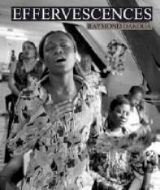Site created by Amplitude. |
||
Effervescences review
Effervescences, Raymond Dakoua – Husson (publisher)
Raymond Dakoua’s Effervescences is the culmination of a series of visits to revivalist churches in Belgium whose congregations are overwhelmingly made up of black Africans.
Shot exclusively in black and white, Dakoua’s photographs aim to document the powerful, embracing effect that evangelical faith can have on African migrant communities, but the execution of that aim falls far short.
Born in the Ivory Coast, Dakoua says that he is interested in the permanence of traditions, the development of cultures, and the problems raised by the integration of African communities into European host societies, especially how these communities interpret the religious rituals they inherited from colonialism.
Yet those interests are not immediately evident in this work. The book never overcomes its major obstacle – just how does a photographer make a 70-page book of people praying interesting, especially without using captions? As a result, we are left wondering who these people are, and why they are important. In the foreword, Francois Delvoye – who accompanied the photographer on some of his church visits – says that “standing next to Raymond Dakoua, I saw emotion and boredom, money and prayers”. That’s four things more than this reviewer saw. The term “effervescence” denotes exhilaration, but its use as a title for this book is a complete misnomer – what is exhilarating about watching a lot of people with their eyes closed sat on a bench?
While there are some strong images within the book, such as the cover shot, they are too few to mention as the majority of the pictures are too similar. Dakoua never gets around the fact that the subject matter is largely inactive and that the interior of each church is the same – white and bare with people sat in rows. A better photographer would have taken a more lateral view and worked around the subject more, such as visiting the homes of some of the congregation or the ministers. Instead, we are presented with a purely one-dimensional view of a faith that we know little about. Consequently, the publication falls flat. At best, the book is a missed opportunity – at worst, a terrible display of editorial judgement.
“The book never overcomes its major obstacle – just how does a photographer make a 70-page book of people praying interesting, especially without using captions?”

